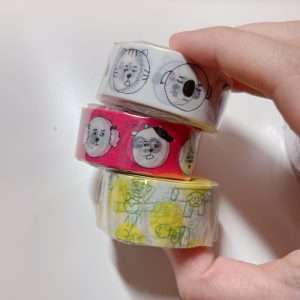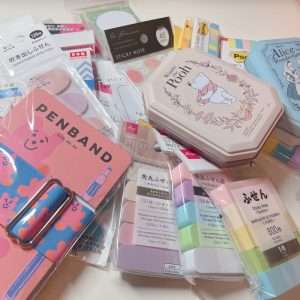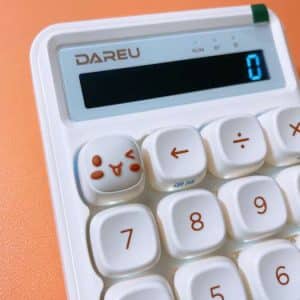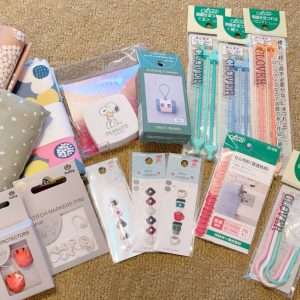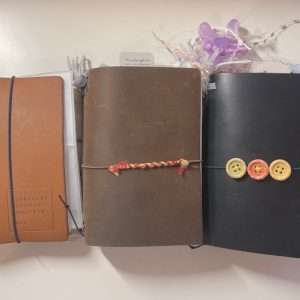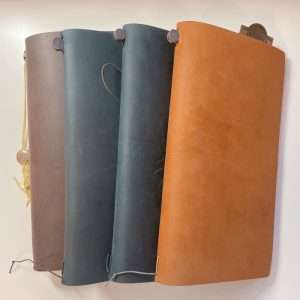Best Hole Punch for Ring Binders: What Worked & What Didn’t
Tried multiple hole punches for ring binders? I did too! With so many options available, choosing the best hole punch for ring binders can be overwhelming. From single-hole punches to adjustable multi-hole models, each type serves a different purpose, and not all of them are created equal. Over the years, I’ve tested various hole punches, exploring their usability, durability, and overall effectiveness. Some exceeded my expectations, while others were disappointing. In this post, I’ll dive into my personal experiences with different hole punches, highlighting what worked, what didn’t, and which features matter most when choosing the right one for your needs.
Table of Contents
How to Choose a Hole Punch
When I first started organizing my planners, I thought any hole punch would do. I quickly learned otherwise. There are some things I wish I had known before buying my first one—like how hole size or guide markings can actually make or break the experience.
With so many options available, finding the right hole punch can be overwhelming, but taking the time to evaluate your needs can make a significant difference. A well-chosen hole punch can streamline your document organization, whether you’re managing a planner, assembling notes, or maintaining a professional binder setup.
Key aspects to consider include the number of holes required, hole size, and additional features that enhance usability. A poorly suited punch can lead to frustration, uneven holes, or difficulty when dealing with thicker paper stacks. By understanding the differences between various hole punches, you can ensure a smoother and more efficient experience tailored to your specific needs.
Number of Holes
- 1-hole punch – Ideal for custom punching but requires manual alignment.
- 3-hole punch – Standard for U.S. binders, convenient for office or school use.
- 6-hole punch – Common for planners and personal organizers, but spacing can vary.
- 7-hole punch – Often used for specific planner systems.
- 10+ hole punch – Commonly found in loose-leaf binders, particularly in Japan and Europe.
- Adjustable hole punch – More versatile, allowing you to punch different binder sizes.
Hole Size
- Standard hole punches usually make 6mm (1/4 inch) holes.
- Some planners and Japanese refills use smaller 4mm holes, which may require a special punch.
Hole Shape
- Round holes – The most common type used in binders and planners.
- Discbound holes – Specialized holes designed for discbound planner systems, requiring a unique punch.
Portability
- If you need to carry your hole punch around for work, school, or travel, a compact and lightweight model is ideal.
- Some punches come with a lock mechanism to keep them closed, making storage and transport easier.
- Heavier models may be more durable but can be cumbersome for frequent portability.
Alignment & Precision
- Built-in guides or rulers help ensure accurate hole placement, reducing the need for manual alignment – I once ruined a full stack of inserts because the alignment was off by just a few millimeters. Since then, I always check for punches with built-in guides.
- Adjustable hole placement settings allow for more flexibility when using different binder sizes.
- Some punches have clear markings for measuring distance between holes, ensuring consistency.
Ease of Use
- Spring-loaded punches require less hand pressure, making them easier to use for extended periods.
- Lever-style punches distribute force more efficiently, reducing hand strain when punching multiple sheets.
- Some models have a lock mechanism to keep them closed when not in use, improving safety and convenience.
Additional Features
- Heavy-duty capability – Useful if you need to punch through thick stacks of paper.
- Scrap collection – Prevents mess by collecting paper waste.
Now, let’s go into my experience with different hole punches. Over the years, I’ve tested various types, from basic 1-hole punches to adjustable multi-hole models. Each had its own pros and cons, and the decision to stick with one depended on factors like convenience, precision, and storage space. Some hole punches were lightweight and portable but required more effort for alignment, while others offered guided placement but were bulkier and took up too much drawer space. Understanding these trade-offs was essential in finding the best hole punch for my needs.
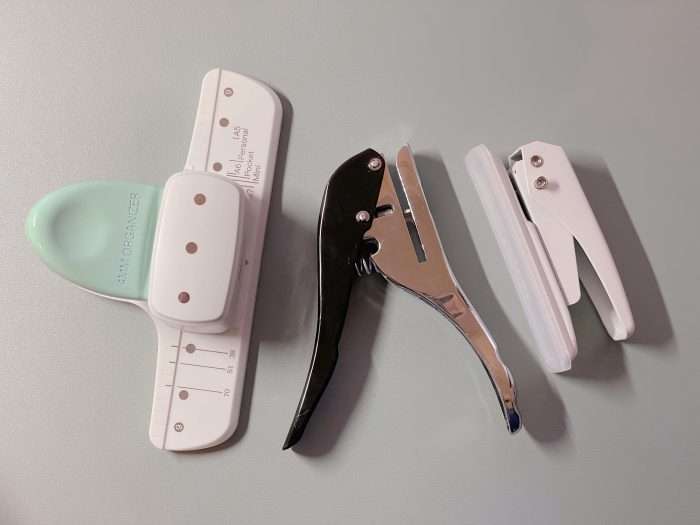
My Experience with 1-Hole Punches
Standard 1-Hole Punch
The first hole punch I ever bought was a small, portable 1-hole punch. It had a neat design, and the bottom cap collected scraps, making cleanup easy. It was lightweight and compact, making it easy to store and carry around. I initially loved how simple it was to use, and it served me well for basic punching tasks. However, over time, I started noticing some limitations.
It still works after years of use, but the hole size is 6mm, which is too large for my A7 and M5 binders. When I tried to align punched pages with my planner, the oversized holes made them shift around more than I liked. Additionally, since it was a single-hole punch, I had to manually align every hole, which became tedious when working with multiple sheets. This led me to search for a better option that would be more precise and efficient.
4mm 1-Hole Punch
When I started using A7 binders and Japanese refills, I realized I needed a smaller 4mm hole punch. The standard 6mm hole punch left oversized holes that didn’t align well with my planner rings. This one was sturdy and made of metal, giving it a durable feel. However, its solid construction also made it quite bulky and heavy, which meant it wasn’t the most convenient option for frequent use or carrying around in my stationery kit.
While it worked well for punching clear folders (I used it for my washi tape binder), I found it frustrating to manually mark the hole positions before punching. Unlike multi-hole punches with guides, I had to align each hole manually, which slowed down the process and increased the chances of misalignment. Additionally, because it required a firm press, punching through multiple sheets at once was difficult. That led me to search for a multiple-hole punch option that could streamline the process while maintaining accuracy.
My Experience with a 6-Hole Punch
I tried a 6-hole punch that had an adjustable hole design to fit different binder sizes, from M5 and A8 to A4. The adjustability was useful, especially when switching between planner sizes, and it allowed for more precise punching. However, I noticed that while it worked well for thinner paper, it struggled with thicker sheets, requiring extra pressure to punch clean holes. This made it less efficient for bulk punching, particularly when dealing with laminated or reinforced pages.
It wasn’t heavy-duty, but for occasional use, it was decent. However, the main issue for me was bulkiness—it took up too much space in my already limited stationery drawer. Unlike smaller, single-hole punches that could be easily stored, this one was larger and less convenient to keep within easy reach. Since storage space is important to me, I ultimately decided not to keep using it, opting instead for more compact alternatives that better fit my needs.
My Experience with a 3-Hole Punch (Winner!)
Finally, I found a compact 3-hole punch with 4mm holes on Amazon. It had clear guidelines for hole placement, meaning I didn’t need to manually mark each hole before punching. This feature alone saved me a lot of time and effort compared to my previous experiences with single-hole punches. The precision of the guides ensured that all my pages aligned perfectly, making my binders look neat and professional.
The slim design made it easy to store, and it even had a plastic cover at the bottom to collect paper scraps, which helped in keeping my workspace clean. Unlike bulkier multi-hole punches, this one didn’t take up much space, making it a convenient option for those with limited storage. Given its ease of use and compact nature, this ended up being my preferred option for my binders, balancing functionality and efficiency perfectly.
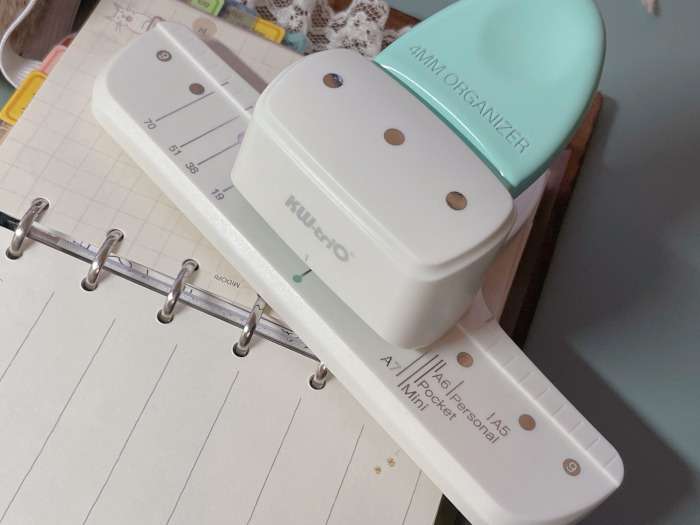
After trying multiple options, I ultimately decided to stick with this punch for my system binder. It provided the perfect balance of precision and portability, allowing me to punch holes quickly without needing to manually align every sheet. The consistent results and ease of use made it an essential part of my stationery setup, ensuring that my planner pages always looked neat and well-organized.
Choosing the Best Hole Punch for Your Needs
Choosing the best hole punch for ring binders is essential for maintaining an organized and efficient system. Whether you are managing a planner, archiving documents, or preparing materials for school or work, having the right hole punch can make a significant difference.
After testing multiple hole punches, I found that choosing the best hole punch for ring binders depends on your specific needs and how you plan to use it. The best hole punch for ring binders should provide clean, precise holes while being easy to use and store. With so many options available, finding the perfect one can be a challenge, but knowing what to look for can make the decision easier. Different binders, planners, and paper types require different hole configurations, making it essential to choose wisely.
Key Factors to Consider
Some people prioritize portability, while others need heavy-duty options for frequent use. Adjustable hole punches can be beneficial for those who use multiple planner sizes, whereas single-hole punches offer more flexibility in placement. Understanding the trade-offs between precision, convenience, and durability will help you find the ideal hole punch for your setup.
- If you need custom punching, a 1-hole punch works but may require careful alignment.
- If you use A7 binders or Japanese planner refills, a 4mm hole punch is a better fit.
- If you want convenience and accuracy, a 3-hole punch with clear guidelines is a great choice.
- If you use various planner sizes, an adjustable 6-hole punch is useful but bulky.
Making the Right Choice
No single hole punch fits every need, but I hope my experience helps you decide which one is best for your setup! Whether you’re a planner enthusiast, a student organizing class notes, or someone managing office documents, selecting the right hole punch can make a significant difference in your workflow.
Take into account factors like portability, precision, and storage convenience before making your choice. A well-suited hole punch will not only save you time but also help keep your documents neatly aligned and secure in your binders. Investing in the right tool can enhance your organization and make your planning or filing system much more efficient.
🖊️ Popular Stationery Reviews
- Japanese Planner Accessories Haul: Stationery Finds from Tokyo
- Best Hole Punch for Ring Binders: What Worked & What Didn’t
- Uni-ball One P Review + Uni-ball One Fica Color Set
- Sew a Notebook Cover: DIY Project for Midori MD Diary
- Traveler’s Notebook Care: Tips and Leather Conditioning Guide
- Craft Organization Ideas: Simple Storage Solutions for Supplies
- Hobonichi Weeks Mega Review: Is It Worth The Type?
🖊️ Explore More Stationery Reviews
Looking for the best stationery to enhance your journaling experience? Check out all my Stationery Reviews for detailed insights, product recommendations, and tips to help you choose the perfect tools for your creative projects!

